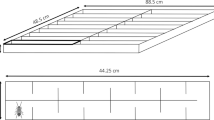Abstract
The home range system of the coelacanth Latimeria chalumnae was investigated along 11 km coastline at Grande Comore, Western Indian Ocean, between 1987 and 1991. 67 individuals were identified on individual white dot patterns. The home range consisted of daytime caves where fish aggregated in groups of up to 14 individuals while at night individuals moved singly downwards to a depth of 250 to 300 m in search of food. Site fidelity of at least 5 yr was found. The coelacanths used several caves within their home ranges. Cave size, cave occupation rate, average and maximum group size and cave preferences were studied. Tracking experiments with ultrasonic transmitters revealed horizontal home ranges of at least 8 km width. Population estimates of 200 to 230 individuals at Grande Comore confirm earlier counts. Large home ranges and highly mobility in a topographically narrow habitat apparently favoured inbreeding of the small local island population.
Similar content being viewed by others
References
Bruton MN, Armstrong MJ (1991) The demography of the coelacanth Latimeria chalumnae. Envir Biol Fish 32:301–311
Emerick CM, Duncan RA (1982) Age progressive volcanism in the Comores Archipelago, western Indian Ocean and implications for Somali plate tectonics. Earth planet Sci Lett 60:415–428
Enright JT (1977) Diurnal vertical migration: adaptive significance and timing, Part 1. Selective advantage-a metabolic model. Limnol Oceanogr 22:856–872
Forey PL (1990) The coelacanth fish: progress and prospects. Sci Prog Oxf 74:53–67
Fricke HW (1993) Die Biologie des Quastenflossers. 16-mm-Film 3210146. FWU Institut für Film und Bild, München
Fricke HW, Hissmann K (1990) Natural habitat of coelacanths. Nature, Lond 436:323–324
Fricke HW, Hissmann K (1992) Locomotion, fin coordination and body form of the living coelacanth Latimeria chalumnae. Envir Biol Fish 34:329–356
Fricke HW, Hissmann K, Schauer J, Reinicke O, Kasang L, Plante R (1991 a) Habitat and population size of the living coelacanth Latimeria chalumnae at Grande Comore. Envir Biol Fish 32:287–300
Fricke HW, Plante R (1988) Habitat requirements of the living coelacanth Latimeria chalumnae at Grande Comore, Indian Ocean. Naturwissenschaften 75:149–151
Fricke HW, Reinicke O, Hofer H, Nachtigall W (1987) Locomotion of the coelacanth Latimeria chalumnae in its natural environment. Nature, Lond 329:331–333
Fricke HW, Schauer J, Hissmann K, Kasang L, Plante R (1991 b) Coelacanth Latimeria chalumnae aggregates in caves: first observations in their resting habitat and social behaviour. Envir Biol Fish 30:281–285
Helfmann GS, Schultz ET (1984) Social transmission and behavioural traditions in a coral reef fish. Anim Behav 32:379–384
Manly BFJ (1991) Randomization and Monte Carlo. Methods in biology. Chapmann and Hall, London
McCosker JE (1979) Interred natural history of the living coelacanth Latimeria chalumnae. In: McCosker JE, Lagios MD (eds) The biology and physiology of the living coelacanth. Occ Pap Calif Acad Sci 134:17–24
Millot J, Anthony J, Robineau D (1972) Etat commente des captures de Latimeria chalumnae Smith (Poisson, Crossopterygian, Coelacanthidae) effectuees jusqu' au mois d'octobre 1971. Bull Mus natn Hist nat Paris (Ser. 3, Zoologie) 39 (53):533–548
Northcutt RG (1980) Anatomical evidence of electroreception in the coelacanth (Latimeria chalumnae). Anat Histol Embryol 9: 289–295
Odor RK, Forsythe J, Webber DM, Wells J, Wells MJ (1993) Activity levels of Nautilus in the wild. Nature, Lond 362:626–628
Romer AS (1959) Vergleichende Anatomie der Wirbeltiere. P. Parey Verlag, Hamburg
Rosen DE, Forey PL, Gardiner BG, Patterson C (1981) Lungfishes, tetrapods, paleontology and plesiomorphy. Bull Am Mus nat Hist 167:159–276
Schartl M (1988) Sex chromosom restriction fragment length marker linked to melanoma determining TU-loci in Ziphophorus. Genetics 119:679–685
Schliewen U, Fricke HW, Schartl M, Epplen JT, Pääbo S (1993) Which home for coelacanths? Nature, Lond 363:405–405
Siegel S (1956) Nonparametric statistics for the behavioural sciences. McGraw-Hill Book Comp. New York
Sokal RR, Rohlf FJ (1969) Biometry. WH Freeman & Comp., San Francisco
Swoboda H (1971) Knauers Buch der Modernen Statistik. Droemer Knauer, München
Warner RR (1988) Traditionality of mating-site preferences in a coral reef fish. Nature, Lond 353:719–721
Westoll TS (1943) The origin of tetrapods. Biol Rev 18:78–98
Author information
Authors and Affiliations
Additional information
Communicated by O. Kinne, Oldendorf/Luhe
Rights and permissions
About this article
Cite this article
Fricke, H., Hissmann, K. Home range and migrations of the living coelacanth Latimeria chalumnae . Marine Biology 120, 171–180 (1994). https://doi.org/10.1007/BF00349676
Received:
Accepted:
Issue Date:
DOI: https://doi.org/10.1007/BF00349676




